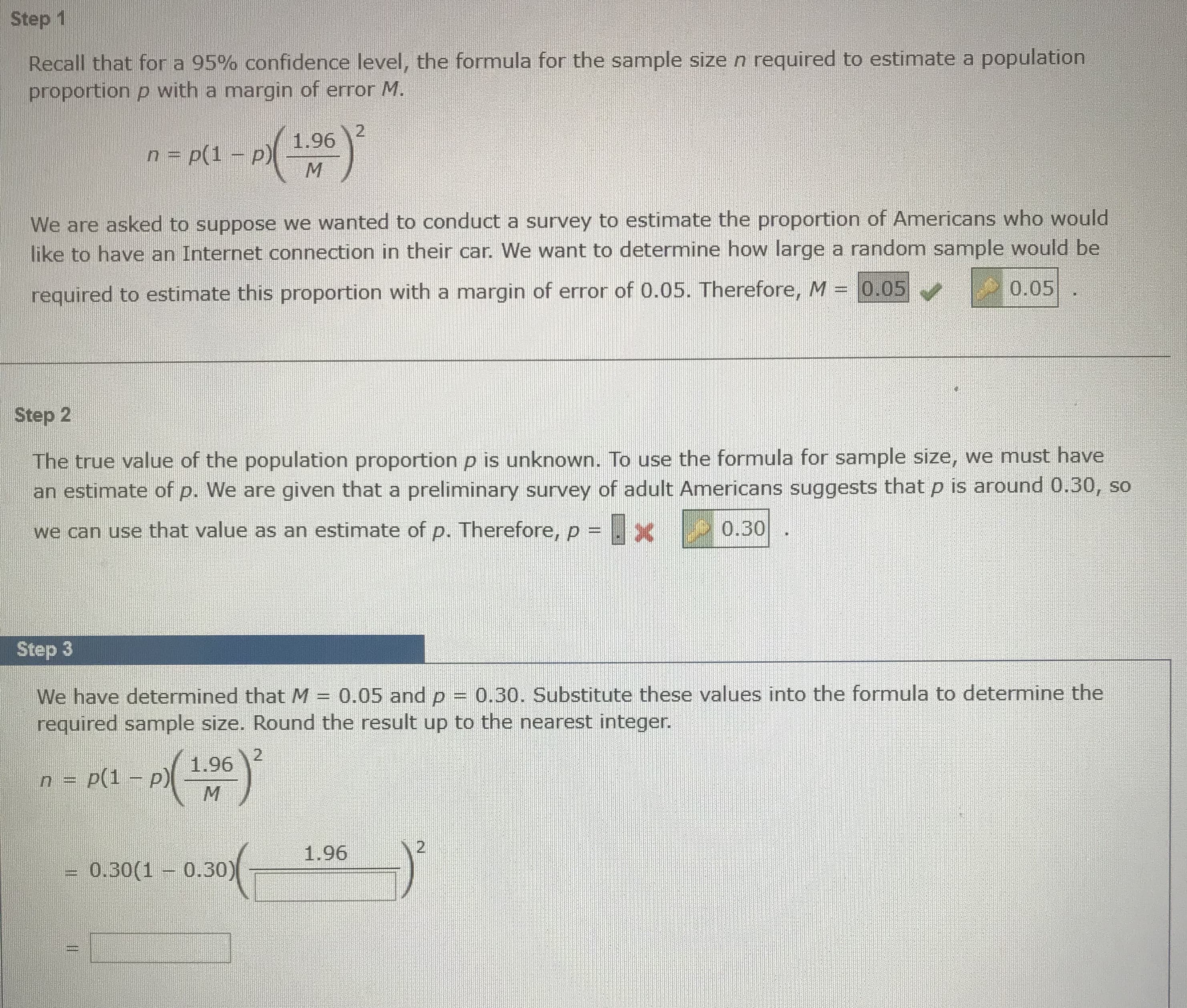Step 1 Recall that for a 95% confidence level, the formula for the sample size n required to estimate a population proportion p with a margin of error M. 2. 1.96 n = p(1 – p) M. We are asked to suppose we wanted to conduct a survey to estimate the proportion of Americans who would like to have an Internet connection in their car. We want to determine how large a random sample would be required to estimate this proportion with a margin of error of 0.05. Therefore, M = 0.05 0.05 Step 2 The true value of the population proportion p is unknown. To use the formula for sample size, we must have an estimate of p. We are given that a preliminary survey of adult Americans suggests that p is around 0.30, so we can use that value as an estimate of p. Therefore, p = 0.30 Step 3 We have determined that M = 0.05 and p = 0.30. Substitute these values into the formnula to determine the required sample size. Round the result up to the nearest integer. 21 1.96 - P(1 – p)( - p(1 - 1.96 0.30(1 – 0.30) 2.
Step 1 Recall that for a 95% confidence level, the formula for the sample size n required to estimate a population proportion p with a margin of error M. 2. 1.96 n = p(1 – p) M. We are asked to suppose we wanted to conduct a survey to estimate the proportion of Americans who would like to have an Internet connection in their car. We want to determine how large a random sample would be required to estimate this proportion with a margin of error of 0.05. Therefore, M = 0.05 0.05 Step 2 The true value of the population proportion p is unknown. To use the formula for sample size, we must have an estimate of p. We are given that a preliminary survey of adult Americans suggests that p is around 0.30, so we can use that value as an estimate of p. Therefore, p = 0.30 Step 3 We have determined that M = 0.05 and p = 0.30. Substitute these values into the formnula to determine the required sample size. Round the result up to the nearest integer. 21 1.96 - P(1 – p)( - p(1 - 1.96 0.30(1 – 0.30) 2.
MATLAB: An Introduction with Applications
6th Edition
ISBN:9781119256830
Author:Amos Gilat
Publisher:Amos Gilat
Chapter1: Starting With Matlab
Section: Chapter Questions
Problem 1P
Related questions
Question

Transcribed Image Text:Step 1
Recall that for a 95% confidence level, the formula for the sample size n required to estimate a population
proportion p with a margin of error M.
2.
1.96
n = p(1 – p)
M.
We are asked to suppose we wanted to conduct a survey to estimate the proportion of Americans who would
like to have an Internet connection in their car. We want to determine how large a random sample would be
required to estimate this proportion with a margin of error of 0.05. Therefore, M = 0.05
0.05
Step 2
The true value of the population proportion p is unknown. To use the formula for sample size, we must have
an estimate of p. We are given that a preliminary survey of adult Americans suggests that p is around 0.30, so
we can use that value as an estimate of p. Therefore, p =
0.30
Step 3
We have determined that M = 0.05 and p = 0.30. Substitute these values into the formnula to determine the
required sample size. Round the result up to the nearest integer.
21
1.96
- P(1 – p)( -
p(1 -
1.96
0.30(1 – 0.30)
2.
Expert Solution
This question has been solved!
Explore an expertly crafted, step-by-step solution for a thorough understanding of key concepts.
This is a popular solution!
Trending now
This is a popular solution!
Step by step
Solved in 2 steps with 1 images

Recommended textbooks for you

MATLAB: An Introduction with Applications
Statistics
ISBN:
9781119256830
Author:
Amos Gilat
Publisher:
John Wiley & Sons Inc

Probability and Statistics for Engineering and th…
Statistics
ISBN:
9781305251809
Author:
Jay L. Devore
Publisher:
Cengage Learning

Statistics for The Behavioral Sciences (MindTap C…
Statistics
ISBN:
9781305504912
Author:
Frederick J Gravetter, Larry B. Wallnau
Publisher:
Cengage Learning

MATLAB: An Introduction with Applications
Statistics
ISBN:
9781119256830
Author:
Amos Gilat
Publisher:
John Wiley & Sons Inc

Probability and Statistics for Engineering and th…
Statistics
ISBN:
9781305251809
Author:
Jay L. Devore
Publisher:
Cengage Learning

Statistics for The Behavioral Sciences (MindTap C…
Statistics
ISBN:
9781305504912
Author:
Frederick J Gravetter, Larry B. Wallnau
Publisher:
Cengage Learning

Elementary Statistics: Picturing the World (7th E…
Statistics
ISBN:
9780134683416
Author:
Ron Larson, Betsy Farber
Publisher:
PEARSON

The Basic Practice of Statistics
Statistics
ISBN:
9781319042578
Author:
David S. Moore, William I. Notz, Michael A. Fligner
Publisher:
W. H. Freeman

Introduction to the Practice of Statistics
Statistics
ISBN:
9781319013387
Author:
David S. Moore, George P. McCabe, Bruce A. Craig
Publisher:
W. H. Freeman